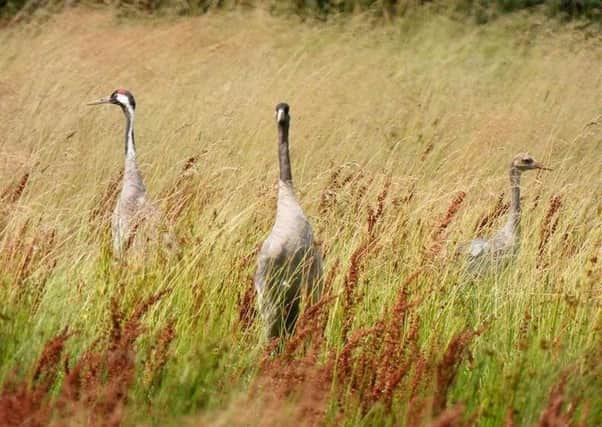Oxfordshire celebrates first crane fledgling in 500 years


Attempts to encourage cranes to breed at the nature reserve have been ongoing for the past six years, as part of the Great Crane Project, and there are now hopes of many more crane chicks to come.The five-year reintroduction project, completed in 2015,saw the first nesting pair – Maple-Glory and Wycliffe – arrive that year, but they failed to produce any offspring.
The arrival of a second nesting pair – Excalibird and Ted – in 2020 changed the fortunes of the Otmoor cranes, and their first chick has now fledged. The as-yet unnamed fledgling, which has ginger colouration, is the first crane to have hatched in Oxfordshire in 500 years.
Advertisement
Advertisement
There has been hope and disappointment in six years since cranes were reintroduced as part of the Great Crane Project, but the recent fledgling success points to a bright future for the species in Oxfordshire.


Damon Bridge, from the Great Crane Project, said: “It’s wonderful to have this success with the cranes at Otmoor. This is one of 14 chicks to fledge this year from the birds reintroduced through The Great Crane Project and marks the best year on record.
“Cranes from the South West reintroduction have now bred in Somerset, Gloucestershire, Dorset, Wiltshire, Oxfordshire, Cambridgeshire and South Wales.
“Outside of the breeding season, when they are highly territorial, cranes are very social birds and form large wintering flocks. The return of the Otmoor pair to the Somerset Levels and Moors is so that they can mix and mingle with the other cranes and increase their chances of finding food through the tough winter months.”
Advertisement
Advertisement
Common crane chicks take 10 weeks to fledge, with the new addition taking its first flight last week, before making a short migration to South West England. In winter, cranes group together before they pair up, with females usually outnumbering the males.
Until then, Otmoor is the ideal place for crane breeding, as they like to have a platform over the water and feed on the insects that live in wet grassland. Cranes have exceptional eyesight, and are also very secretive, so reeds and tall sedge grass provide an ideal hiding place.
A haven for wildlife, Otmoor reserve is based around an expansive floodplain grazing marsh, which is home to wading birds and wildfowl all year round. Warblers and songbirds add to the ambience of the beautiful atmosphere from their homes in the reedbed.
Otmoor hasn’t always been such a perfect habitat for wetland birds. In Victorian times, Alexander Croke attempted to drain the moor to create a land enclosure for farming.
Advertisement
Advertisement
It stayed in this condition throughout the 20th century, as parts of the site changed hands from the Ministry of Defence to Friends of the Earth, and eventually the RSPB in 1997. Since then, the wetlands have been restored and wading birds have returned.
Bitterns, marsh harriers and curlews have come to nest at Otmoor, alongside the cranes. This year has been the first time three bitterns boomed in the nature reserve’s history. There have also been six fledged marsh harrier and nine curlew chicks in 2021.
To learn more about the Otmoor cranes, their journeys and to see pictures of them as chicks, visit the Great Crane Project website at https://www.thegreatcraneproject.org.uk/.
This year you can help make the rare wet grasslands of Otmoor Nature reserve even bigger and better.
Advertisement
Advertisement
For many years the UK’s nature has been forced into smaller and smaller spaces, with a shocking 41% of our species declining since the 1970s.
The RSPB – with your help – are aiming to purchase more land at Otmoor to help cranes, bitterns, marsh harriers and many other species thrive once more. Donations can be made here or by calling 01767 693 680.